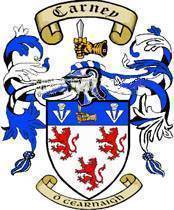
Carney & Wehofer Family
Genealogy Pages
Trader Arthur CARNEY (KEARNEY)
-
Name Arthur CARNEY (KEARNEY) Prefix Trader Birth Abt 1750-1760 North Carolina 
Gender Male FamilySearch ID G43N-DM8 _UID C6ECD0AD37044F7B994BB891212C2A03DBDF Death 6 Jul 1804 Mississippi 
Person ID I112681161 Carney Wehofer 2024 Genealogy Last Modified 16 Sep 2024
Father Captain Arthur CARNEY (KEARNEY), b. Abt 1732, Orangeburg, South Carolina, British Colonial America  d. 1783, Georgia
d. 1783, Georgia  (Age ~ 51 years)
(Age ~ 51 years) Mother Elizabeth ADERTON, b. Abt 1733, Rowan County, North Carolina  d. Abt 1769, Mississippi
d. Abt 1769, Mississippi  (Age ~ 36 years)
(Age ~ 36 years) Family ID F50573639 Group Sheet | Family Chart
Family 1 Hokey Indian Wife CHOCTAW d. Yes, date unknown Children 1. Arthur CARNEY, b. Abt 1775, Choctaw Indian Territory  d. Yes, date unknown
d. Yes, date unknown2. Capt. Jeremiah (Jerry) CARNEY (KEARNEY), b. 1786, Mobile, Mississippi Territory  d. Jul 1848, Madison County, Mississippi
d. Jul 1848, Madison County, Mississippi  (Age 62 years)
(Age 62 years)Family ID F50573462 Group Sheet | Family Chart Last Modified 29 Aug 2016
Family 2 Celeste BRASHEAR, b. Abt 1781 d. 1798 (Age ~ 17 years) Marriage 1797 [1, 2] - _STATMARRIED
Children 1. Elizabeth Louisiana CARNEY, b. 1798 d. Yes, date unknown Family ID F50573464 Group Sheet | Family Chart Last Modified 29 Aug 2016
Family 3 Matilda d. Yes, date unknown Marriage Abt 1800 Family ID F50573644 Group Sheet | Family Chart Last Modified 29 Aug 2016
-
Photos 
Early Indian Tribal Area Map
-
Notes - I preface this particular person's lineage with the caveat that this is a 'best evidence' assumption based on facts and DNA evidence.
Arthur Carney was born about 1755-1760 in North Carolina, to the son of Arthur Carney the Indian Trader and Elizabeth Aderton. Like his father, Arthur became an Indian Trader to the Choctaw's and was found to have a trading post under the Spanish Grand Party in 1787 (after his father's death) in Spanish Territory that was at the time known as east Florida in the Mississippi Valley near New Orleans, at the mouth of the Yazoo River. This trading post provided beef from Texas Trading Companies, among other items.
While establishing himself as an Indian Trader, Arthur was offered, and took up a Choctaw Indian wife named Hoke (Hokey) from a prominent family, and from this union his wife bore a child and named him Jeremiah (Jerry) Carney, namesake of his father's son Jeremiah, his uncle. This wife is also documented in the baptismal certificate on file for his son Jeremiah. He also had another son by Hoke, who he named Arthur after his father, and who is found in the Armstrong Rolls when forced in the emigration to Oklahoma in later years. In addition, he had a white wife named Matilda, and much later another Celeste Brashear with which he had one child Elizabeth Louisiana Carney. Celeste died in childbirth in 1798 after 1 year of marriage, and daughter Elizabeth was orphaned at 6 years of age when Arthur was also killed on 6th of July 1804 at age 49.
To fill in a few years in between; we find in various documents that Arthur was an active Indian Trader and a man of wealth and prosperity, with friends of other prominent traders such as Turner Brashears, Louis Leflore, Alexander Fazier and others. In later years he was in a partnership in the mercantile business with John Edgerill, which ended in 1802 when Elderill filed suit for an improper accounting by Carney. But, before any decree or payment was made, Arthur died in unknown circumstances. Not long after that, Edgergill died in 1807 and the suit was later renewed in the name of Prosper and Richard King, Edergills heirs or assignees. The Kings obtained a decree against Arthur's estate, now held by his widowed wife who had now married John Cummins. The decree also extended to Joseph Nichols and his wife Elizabeth who was the daughter of Arthur Carney. John Cummins was the administrator of Arthur's estate, as mentioned by Kings attorney.
A major setback for Arthur occurred during the American War of Independence started in 1776, when like his father (who died in the war), he sided as a loyalist with the British. At the end of the war, Arthur was given 6 months to settle his estate and was then banished from the Colonial Union under the Act of Attainder, Banishments and Confiscation and selling any effected assets quickly, as he took refuge in Spanish eastern Florida (later known as Louisiana and Mississippi). In 1784, he was in court in East Florida, in a case against Manuel Solano and Arthur Carney. He denied charges of Theft but admitted that they beat up a negro named Frank.
Other Sources: Over 500 pages of Notes, Records and Files at the Carney DNA Project Jim Carney www.avocadoridge.com/carney March 2010
- I preface this particular person's lineage with the caveat that this is a 'best evidence' assumption based on facts and DNA evidence.
-
Sources
